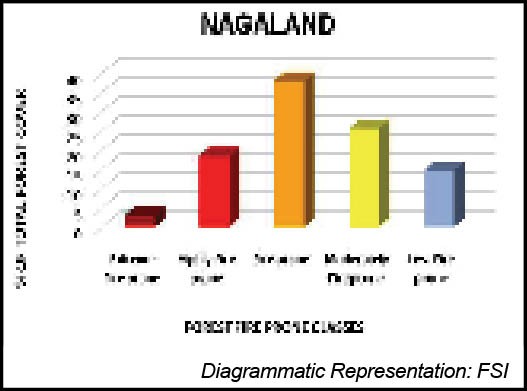
Morung Express News
Dimapur | June 22
While forest fire continues to be a major threat to the environment and ecosystem, budget allocated for better forest fire management has only gone down every year.
According to the 4th edition of the “State of India’s Environment in Figures 2019” an annual compilation done by Down To Earth, the fortnightly which Centre for Science and Environment (CSE) helps publish, 20 states, UTs in India recorded a dip in funds for fight forest fires in 2018-19 over 2015-16.
It stated that funds to avert forest fires have gone down by 12 percent during the intervening years.
Nagaland also figures among the states where funds released by the government have gone down drastically over the years. According to the report, the Nagaland government released 123 lakh during 2015-16; 170 lakh during 2016-17, 93 lakh for the year 2017-18 and a mere 63 lakh for 2018-19.
This, notwithstanding the fact that forest fire is extremely common in the state, particularly during the dry and windy season and the government ill prepared to tackle the threat.
Most of the sanctuaries, reserved forests as well as those outside protected areas always remain under threat from forest fires every year. Majority of the forest fires are a result of human activities. Jhum cultivation also contributes to the forest fire incidents reported in the state. Many of the forest fire incidences that occur in the state go unreported because of lack of manpower, infrastructure and technology to detect the same.
One of the recorded major forest fires was reported in February 2015 when a huge fire broke out on Mount Japfü, Nagaland's second highest peak.
The fire was described as one of the country's worst in recent history and it was estimated that almost seven kilometers of lush swathes of the peak was affected. The fire was finally brought under control with the help of Indian Air Force (IAF) helicopters. This was also the first time in Indian history that helicopters were used to combat forest fire.
In the most recent, in November 2018, hundreds of acres in the picturesque Dzukou valley were reduced to ashes. The fire was reportedly caused by the carelessness of some trekkers.
Nagaland has 12, 489 sq km of total fire-prone areas
According to the Forest Survey of India (FSI), Ministry of Environment, Forest & Climate Change, Forest fires cause large scale destruction of forest resources and biodiversity in the country every year. One forest fire incident may nullify all efforts of conservation and plantations done in the past several years.
A recent analysis done by FSI, shows that nearly 36% of country’s forests are prone to fires and of this, over 10% are highly prone. Forest fires in India are largely of anthropogenic origin and therefore preventable to a large extent.
The FSI reported that Nagaland has 12, 489 sq km of total fire-prone areas and prone classes which is then categorized into extremely fire prone, highly fire prone, moderately fire prone and less fire prone.
Breaking it up, Nagaland has 3.05% (380sq km) of forest cover under extremely fire prone class, 18.48% (2309 sq km) under highly prone class, 38.05% (4752 sq km) fire prone, 25.65% (3204 sq km) moderately fire prone, 14.77% (1844 sq km) less fire prone.
From 2004-05 to 2017, the FSI in its technical report, “Identification of fire prone forest areas based on Gis analysis of archived forest fire points detected in the last thirteen years” detected 11296 forest fire points in Nagaland.
The FSI report also mentioned that Northeastern states have reported the highest number of forest fire incidents in the country and northern states the lowest.
The eight NE states - Arunachal Pradesh, Assam, Manipur, Meghalaya, Mizoram, Nagaland, Sikkim and Tripura – recorded over 15000 fire alerts or incidents on an average each year, said the report released in 2017. The average has been calculated on the basis baseline data collected between 2003 and 2016.
Apart from public awareness and their participation in controlling forest fires, use of all the technological options for prevention, detection, early warning, firefighting and damage assessment should be employed under a scientifically prepared forest fire management plan for each district or forest division, the FSI report suggested.


